
Keyword research is a science and an art.
And that’s why it’s one of my favorite topics to discuss.
There are tons of different factors at play.
You can’t just go after the biggest keyword in your industry.
Sure, search volume is important. You want to rank for big terms that people are already searching for.
But there are some problems with the biggest keywords.
For example, you’ll probably have to compete against massive brands.
That means your chances of actually ranking aren’t good. It might take you years and years to see any results.
Most people can’t wait that long.
I know I can’t. I’m impatient.
I want to see results immediately.
I want to make sure that all of the time and effort I’m spending on something is worth it at the end of the day.
And that brings us to the second problem with big keywords.
They’re often revolving around vague topics like “content marketing.”
That keyword might bring in a ton of traffic, but the number of buyers you get from a keyword like that will be low.
Most of the visitors will be interested in blog posts and information.
All of that is good. You can get them to sign up for your newsletter and other lead magnets.
But again, it won’t give you the results you’re looking for anytime soon.
So how do you fix that?
How do you find keywords that will help you rank in the near future while also building your bottom line?
Here are six of my favourite keyword research tools to start with.
1. Google AdWords
Starting this list with Google AdWords might be a little confusing.
Isn’t this for, you know, advertising?
Of course it is.
But it also has a few hidden gems inside that can give you revenue-generating keywords in seconds.
Let’s start with the Google Keyword Planner that you might already be familiar with.
This tool will help give you volume and competition feedback for different keywords.
However, I don’t like using it for that.
Why not?
The data is pretty unreliable, to be honest.
Instead, I like to use it for a few different purposes.
The first is competitive analysis. For example, you can drop a website or landing page URL into it and instantly see what keywords they’re targeting.
Take your closest competitor or another similar service and drop it in the bar below, like so:
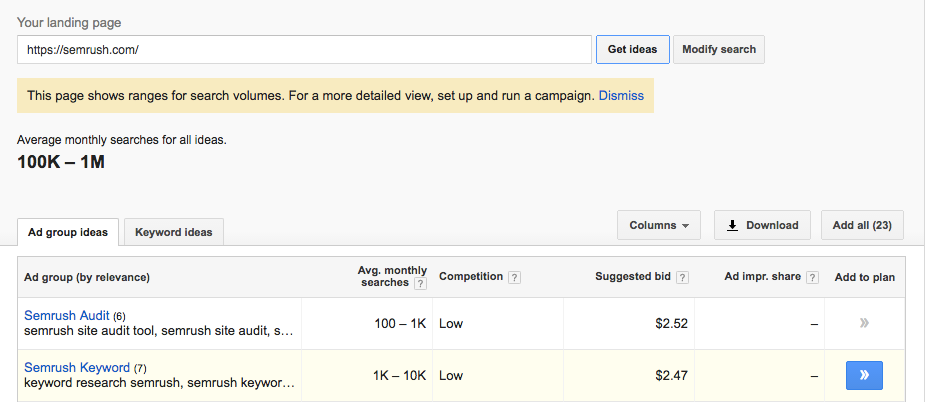
Now, the Google Keyword Planner will recommend dozens of related terms.
You’ll be able to take these terms and research them further later.
Or, better yet, you can get instant feedback by loading some of the best ones into AdWords directly.
That’s the other thing I like about this tool. It will help you organize these keywords into Ad Groups.
So you can quickly browse through, check the ones you like, and then click the little blue arrow icon on the far right-hand side.
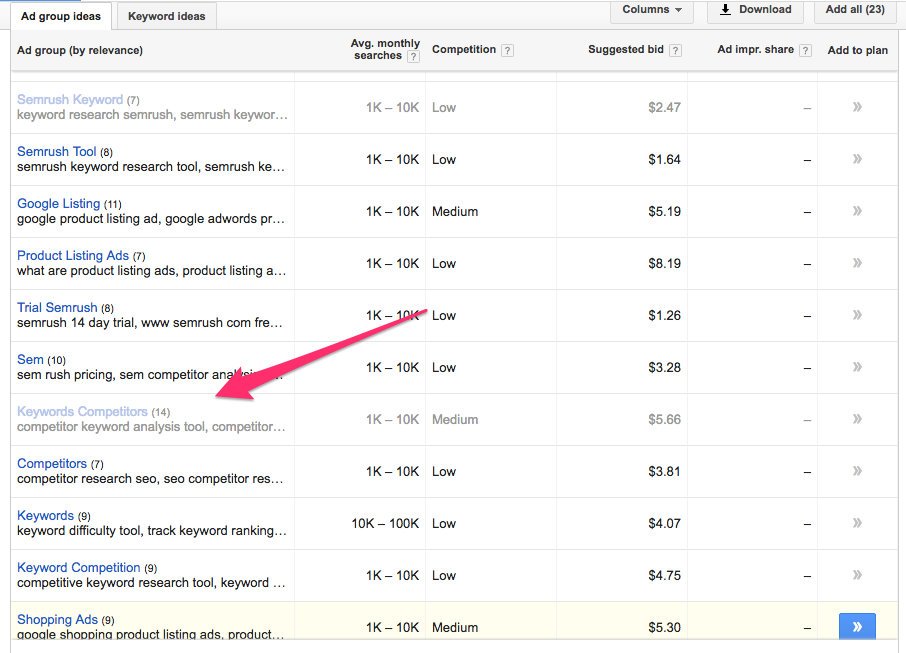
That will instantly transport these terms into your account so you can start running ads.
There are two additional benefits to doing keyword research with AdWords.
The first is that it will quickly help you identify the “money” keywords. These are the ones that don’t just drive traffic but also convert.
The second reason is that it will help you uncover “money” keywords that you probably never had on your radar.
Here’s how that works.
In AdWords, you bid on keywords. But you pay for search terms.
That’s a massive difference. Check out this image below and I’ll explain:
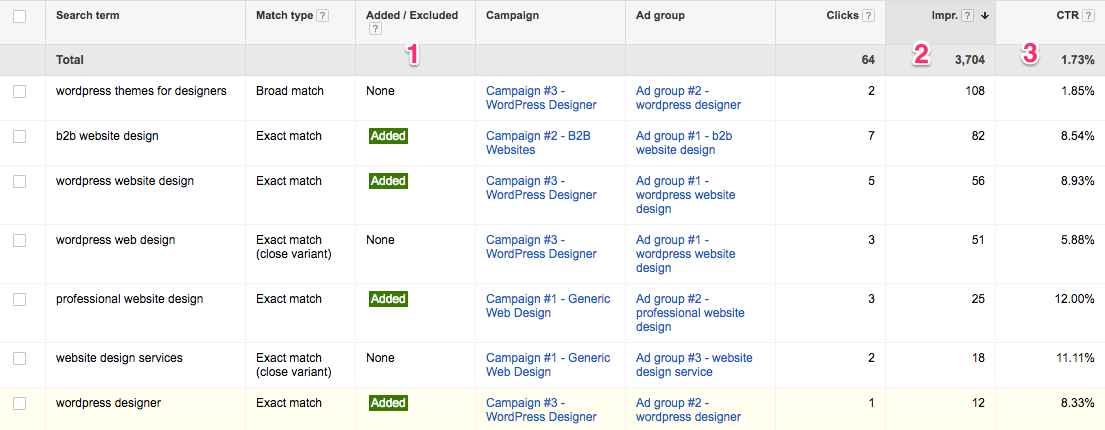
Let’s take it step-by-step.
1. Added / Excluded: This column tells you if the search term is added to a campaign, excluded as a negative keyword, or neither (none).
Why is this important?
Check out the very first keyword, “WordPress themes for designers.” It’s showing up as “None.”
I’m already paying for this term, and yet it’s not showing up anywhere in my campaigns!
The reason has to do with match types. When you use a broad match type, you allow for related terms to show your ads.
I’m getting clicks and interest from this term, but I don’t even have an ad or landing page created for it.
That explains the low results.
2. Impressions: Honestly, I’m not a big fan of measuring impressions.
It’s a vanity metric that just tells you how many people are seeing your ad.
Eyeballs don’t drive revenue, so I usually ignore it.
But it can be helpful for keyword research.
For example, the term we just identified is receiving the most impressions. That means people are really interested in it!
Except, check out the column next to it.
3. CTR: The click-through rate can help you identify performance.
It tells you how many people have seen the ad vs. how many clicked on it.
Check out how low the CTR is for this first keyword.
It’s low because I don’t have it added to a campaign. That keyword never dawned on me.
So I don’t have a specific ad targeting it.
See how that works?
Sure, you have to be willing to spend a little money up front. However, you don’t need to spend a lot.
You’re not necessarily trying to generate leads and customers from this exercise.
The point is to quickly sift through a ton of keywords to help you prioritize the winners over the losers.
2. Google Analytics
You just spent a little money on the first step, so let’s save you some on the second.
Google Analytics has a few hidden gems inside.
You’ve probably never even used many of them before.
Most people go straight to the traffic data or conversions.
Instead, let’s start with the Google Search Console (formerly Webmaster Tools) integration.
You’ll have to sign up for both, and then integrate them. But then you’ll get “query” data directly inside Google Analytics.
Under “Acquisition,” look for “Search Console” and then “Queries.”

This will display some of the search terms people are already using to reach your site.
However, it’s not my favorite Google Analytics tool.
Instead, I like looking at the site searches that are already happening.
For example, most blogs will have a search bar on their site. Check out the sidebar to see mine.
People will use this daily to find new content on specific topics.
These are the topics that your audience is interested in most. But for some reason, they can’t find them easily.
Thankfully, Google Analytics can tell you exactly what people are looking for so you can help them.
Start by enabling site search and then look for “Behavior.”
Next, look for the “Site Search” drop-down and then “Search Terms” under that.
Now, you’re getting a list of the most common words people are searching for. Google Analytics will even help you see the number of times someone searched for each one.
So, you have built-in priority. You can see exactly what people are looking for the most. And then you can try to make those things easier to find.
Pretty cool, right?
There’s one last report inside Google Analytics that I love to use.
This time, look under “Audience” to find the “Interests” drop-down. Then click on “Affinity Categories” to pull up something that looks like this:
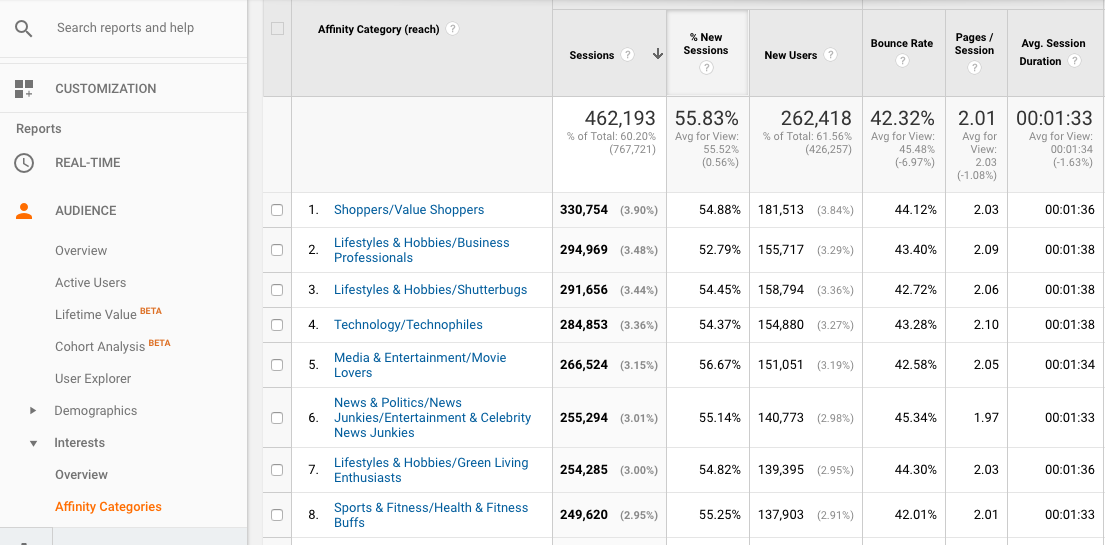
This report shows the related interest categories of your website users.
Once again, this gives you completely new insight.
For example, let’s say you’re a hotel website.
You might have several different types of customers, from families to singles to adventure-seekers.
How do you know which audience to target first? How do you know what kind of content to start creating this month?
The Affinity tab can help you figure this out. You’ll instantly see whether visitors would like to hear about family-friendly activities or new hiking and sailing tours.
3. Google Trends
Let’s look at one more free Google product before we head to some paid tools.
Most keyword research tools use historical data.
That means the majority of their information is old. It could be a few months or even a few years old.
They’re using past data to help you predict which keywords will always have some interest.
However, the downside is two-fold.
First, past behavior is no indication of future performance. Take “DVD movies.”
Most keyword research tools will show a bunch of search volume for it. However, do you really want to be in that business? I don’t think so.
The second issue is that many of these ‘established’ terms are highly competitive. That means they’re going to be tough to rank for in the near future.
It will most likely take you weeks or months to see results.
That’s why Google Trends is important.
Here, you can find recently-trending topics to take advantage of instantly.
It’s like surfing. You can spot the trend as it’s developing and be the first to catch the wave.
Then you can ride it all the way before anyone else realizes what’s happening.
Here’s a perfect example:

Five years ago, “influencer marketing” wasn’t a thing. Nobody was even talking about it.
But look at what’s happened since then.
Another way to use trending topics is for timing.
For example, The Emmy Awards aired recently. It only comes around once a year.
That means nobody cares about it the other 11 months out of the year.
But with Google Trends, you can spot the number of weeks leading up to the event that it begins to trend.
You can see when people start expressing interest so you can perfectly time new content, ads, or campaigns.

The best part about these trending topics is that they’re new.
That means there’s little-to-no competition for them if you plan ahead.
The downside, of course, is that after the trend is over, traffic tends to die out, too.
So, it shouldn’t be your only keyword research strategy.
But, it can give you some short-term boosts while you’re waiting for the longer-term, evergreen content to take off.
4. Moz Keyword Explorer
Keyword volume isn’t the only important criteria, as we’ve discussed.
You also need to consider the competition. If it’s too tough, you might not see the first-page ranking for years.
There’s no simple way to gauge this competition level, though.
It usually requires a time-consuming dive into link profiles so you can figure out what it will take to beat them.
Fortunately, a few paid tools can help to speed up the process.
And that’s where Moz has done an excellent job with their revamped Keyword Explorer.
Type in a few keywords and you’ll get the basic information like volume and competition.
But now, you’ll also get difficulty and opportunity scores, too.
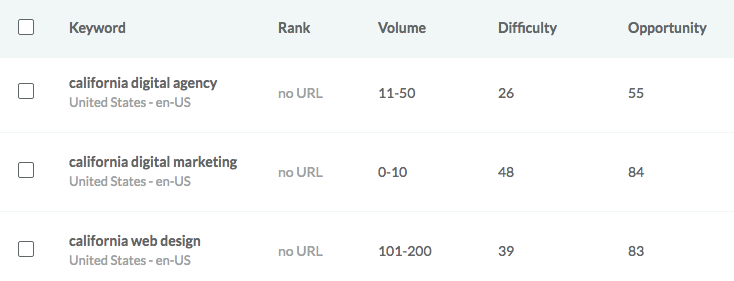
These can help you quickly cut through the clutter.
You can use them like shortcuts to figure out which have the most potential.
The tool will also give you recommended terms based on similar searches. And, you can add those all into a list for a specific campaign.
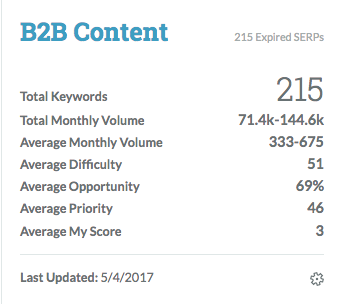
Now, you can see average volume, difficulty, opportunity, and priority scores across all the keywords in this one list.
You can use this technique to compare the potential cost vs. benefit of different content campaigns, for example.
Let’s say you settle on one specific keyword to target.
You can also use the tool to look into the individual websites that are already ranking for it.
For example, here’s what the first few results look like for “SEO tips.”
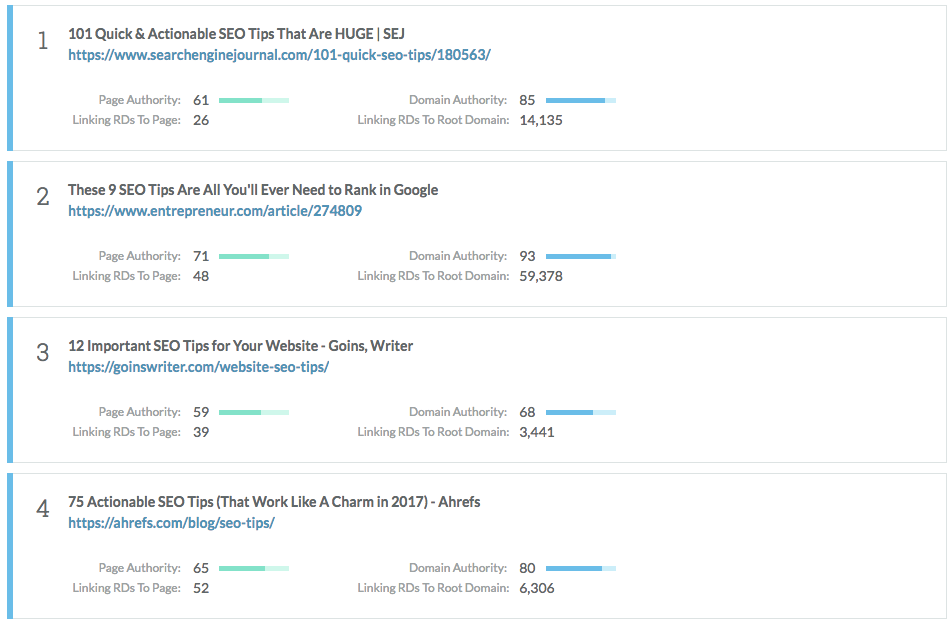
You not only get the website and page or post, but you also get to see some of their individual link metrics.
This is another easy way to do competitive research without having to collect this data manually from different sources.
5. SEMrush
SEMrush is mostly known for its advertising data.
However, as we’ve seen, this can often come in handy for keyword research.
You don’t just want popular keywords. You want profitable ones. And that’s what AdWords is all about.
SEMrush can help you break down these profitable keywords in competitive niches.
You’ll get some overlapping data, like volume or competition.
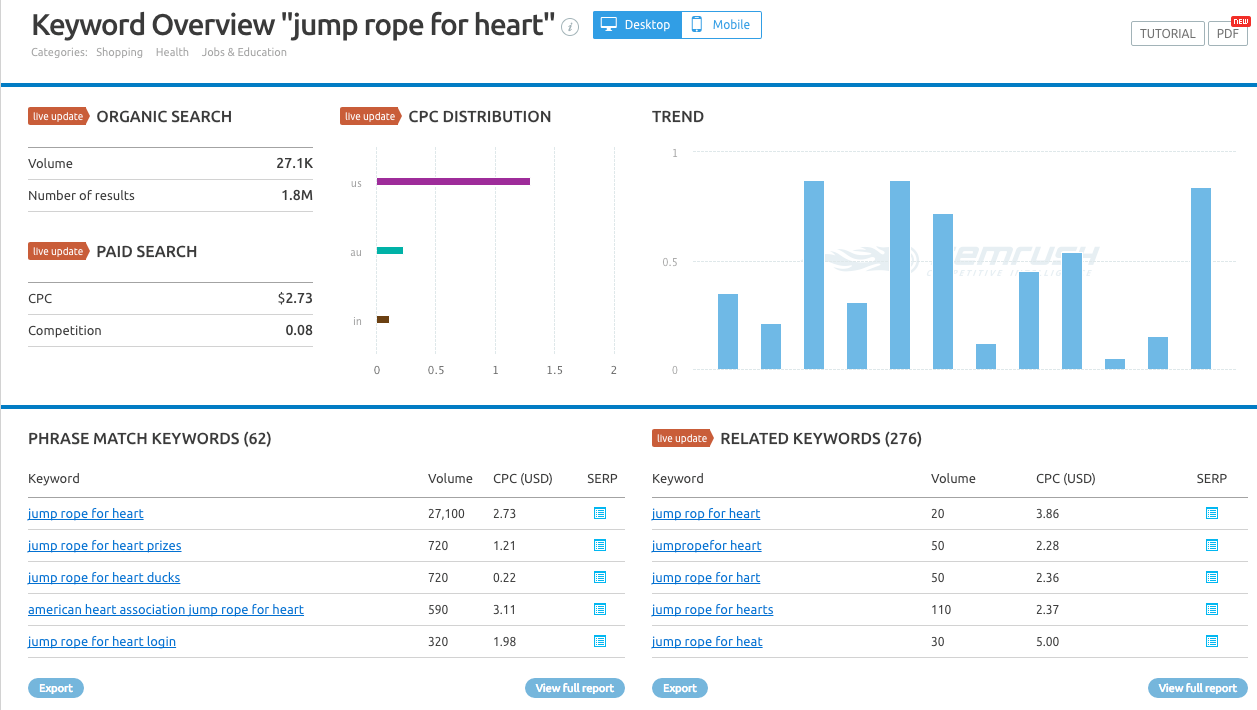
However, there’s another reason why I like this tool so much.
Check it out:
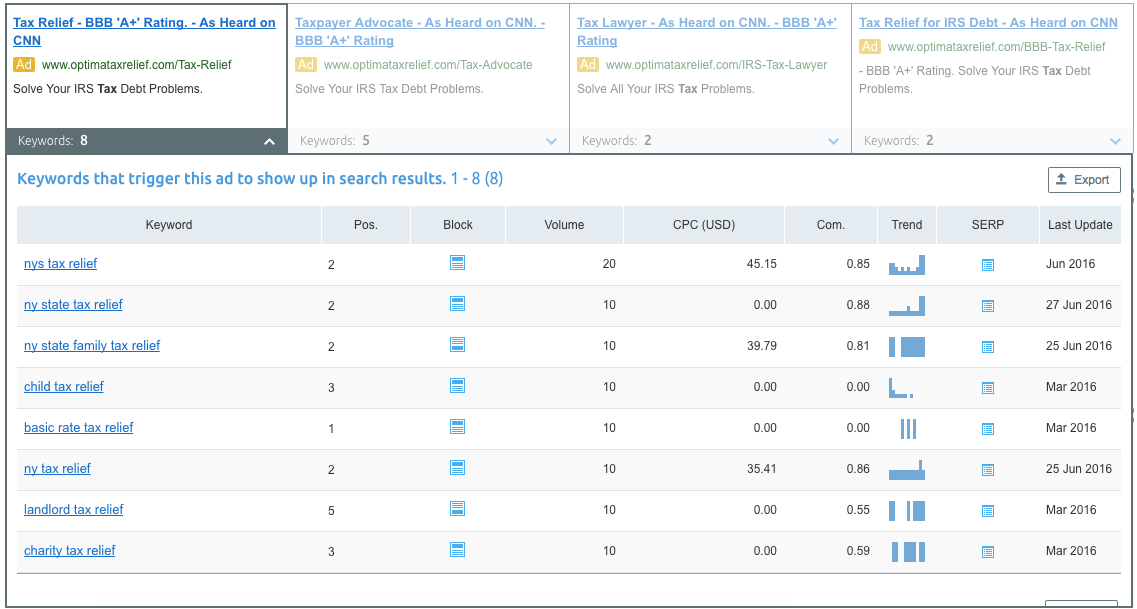
SEMrush will show you all of the keywords a competitor is paying for.
But it will also show you the ads they’re using for each of those keywords.
Why does that matter?
Because your search engine result page (SERP) CTR is becoming more important than your ranking.
The only reason to conduct keyword research is to rank. The only reason to rank is to get more site visitors.
Rewriting your title tags to mimic those from ads can help increase the number of clicks you get.
That means you don’t have to rank in the first position anymore.
Instead, you can rank a few spots lower but still get the most visitors by having the absolute best copy on the page.
Studying the best-performing ads for that keyword can make this happen.
6. WordStream
The last two tools are awesome.
But, you also have to pay for them.
That means you’re going to have to spend somewhere between 50-100 bucks a month to get access.
The problem is that keyword research is an ongoing commitment. You’re never truly ‘done’ with keyword research.
$100 multiplied by twelve months means over a thousand bucks a year for a single tool.
That’s why I like WordStream’s free alternative.
They just recently released a new free Keyword Research tool that will give you many of the same benefits.
For example, you can drop in a competitor’s URL along with their industry and location.
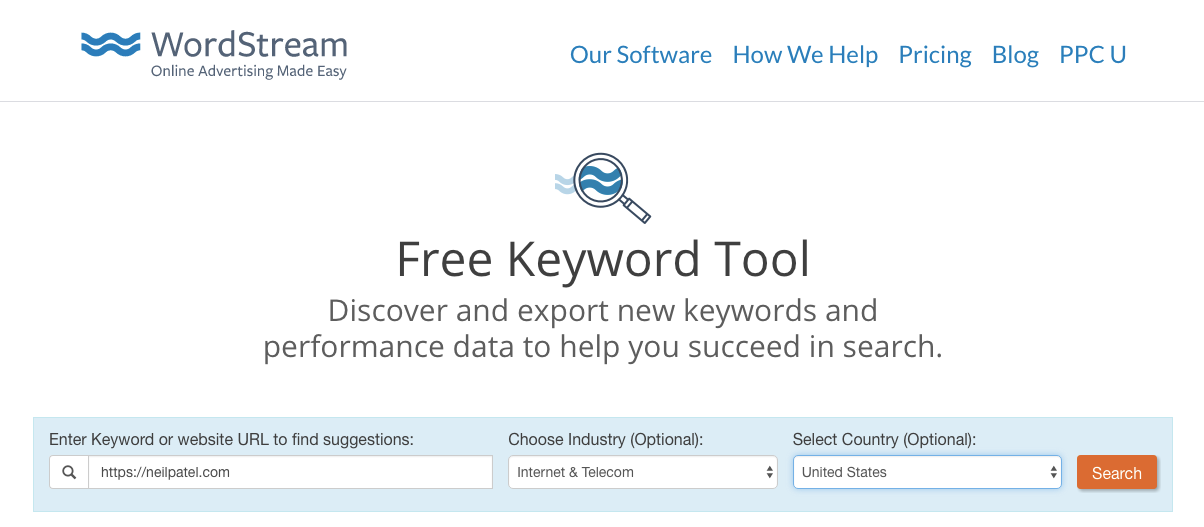
Don’t forget to take this last factor into account.
Your results will differ based on location. Keyword search volume and competition will look different in England than it will in the U.S.
WordStream’s tool will deliver the most popular keywords and their volume range.
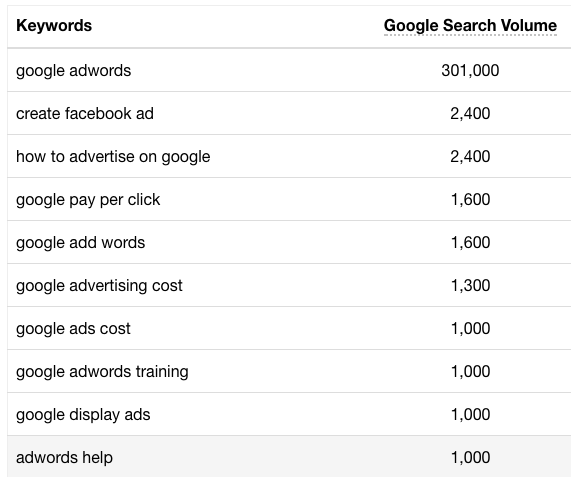
Even better, though, is the opportunity data we’ve highlighted before.
For example, let’s say you’re using it to research long-tail keywords.
You can use the opportunity column to quickly filter out the best potential terms to start with.
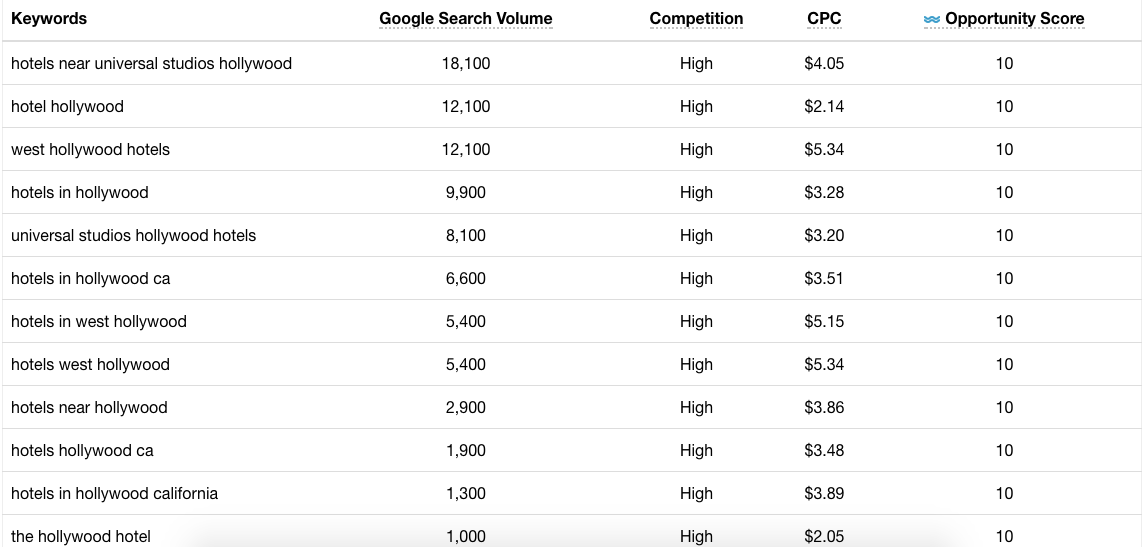
Conclusion
Keyword research is a never-ending process.
Unfortunately, it’s also a time-consuming one.
Back in the old days, I had to collect everything manually.
It would take hours to pull everything together. Then, I’d have to drop it into Excel and get creative with Pivot tables.
We would spend entire days on this for clients with my first consulting company.
Now, you can do the same amount of work in a few minutes.
The 6 tools listed here will help you find popular keywords. They’ll help you find trending ones to capitalize on before anyone else can react.
But best of all:
They’ll help you find profitable keywords that turn visitors into customers.
That’s the goal at the end of the day, right?
Don’t get caught up doing “SEO” for rankings or traffic. Sure, traffic and links are important.
But the only thing that really matters is revenue.
Everything else is just a distraction.
What’s your favourite keyword research tool out there right now?
Source:NeilPatel




